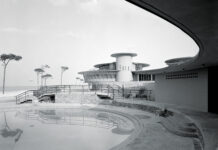
Sometime during the winter of 1942, a dozen crewmen on board the merchant freighter SS Azalea City assembled for this informal photograph. Most of them kept a straight face, though a few smiled, and the two chaps at lower right engaged in a little tomfoolery — one with his booted leg playfully thrown across the shoulder of the other, who appears ready to “cock a snook,” or thumb his nose, a beloved gesture at the time. Mercifully, none of these men knew that within a few short weeks they would be lost at sea, their actual fate only revealed after the conclusion of World War II with American access to German naval records.

The Crew
The Azalea City was a 22-year-old steel-hulled vessel of 5,000 tons owned by Mobile’s Waterman Steamship Corporation. On February 16, 1942, she left Port of Spain, Trinidad, carrying a cargo of linseed oil for Philadelphia. Her master was George Robert Self, a native Mobilian, and the crew included two officers and 35 men — mates, cadets, ordinary and able seamen, engineers, oilers, wipers, mess men and a cook. Most were American, including a man from north Alabama, and one was British, one Norwegian, one Italian, one German and one Puerto Rican.
Unarmed
The United States had declared war on Nazi Germany just two months earlier, but the Azalea City’s master was innocent of wartime precautions, sailing unarmed, unescorted and in a straight line. He was hardly alone in that, and German U-boat captains gleefully exploited their advantage among the lumbering American merchant fleet, declaring the first months of 1942 the “Happy Time” when they sank dozens of allied ships. Only later would the allies adopt seaside blackouts, convoys, destroyer escorts and torpedo planes in order to improve merchant ships’ chances.
Under Attack
When the Azalea City failed to reach Philadelphia that winter, she was declared lost with all hands, cause unknown. After the war, German records revealed the full story. On February 21, U-432 spotted the ship in heavy seas 125 miles east-southeast of Ocean City, Maryland. Over the next several hours, U-432 captain Hermann Eckhardt stalked the freighter, but his first torpedo streaked astern of the quarry. Given the conditions, it is doubtful the Azalea City’s crew even knew the ship was under attack at that point. She did not send a distress signal. Eckhardt crossed the merchantman’s wake, came about and loosed another shot from only a half mile away. His aim was better this time, and the torpedo slammed into the freighter amidships. A third projectile provided the coup de grace, causing the Azalea City to capsize. There were no survivors.

Missing at Sea
The ship’s roster lists every man on board, but who exactly posed for this image is unknown. Could one of them have been Thomas Abraham Ervin, age 23, the cook; or 33-year-old Stephen Douglas Hester, a wiper; or 44-year-old Thomas Jefferson Lively, the bosun? Alas, we cannot say. But there they are, captured by the camera, poker-faced, smiling or clowning, 80 years after they disappeared beneath the cold, gray Atlantic.





